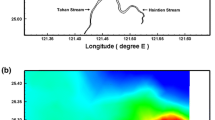Abstract
Water levels and flows in the Singapore coastal waters are driven by the complex interactions of the Indian and Pacific Ocean tides, seasonal monsoon-driven contributions and also forced by local winds. The Singapore Regional Model was developed to simulate hydrodynamics in the Strait of Singapore which produces representative sea level variation in this region. However, resolution and alignment of the grid system of the model with respect to depth contours in some of its subregions, i.e., the Johor Estuary area require further improvement. For this, the grid system of the model was modified and compared the simulated results with field measurements. The computed flow velocities agreed better with field observations when the grid resolution was increased. However, improving the alignment of the grid with the channel boundary (with a much lower increase in grid resolution) provided a substantially larger improvement of the model performance. The grid modification greatly influenced the computed salinity in the estuary, while water levels are slightly affected. Further analysis of model results showed a pronounced ebb tidal asymmetry generated by the O1–K1–M2 tidal constituents in the estuary.
















Similar content being viewed by others
References
Arakawa A, Lamb VR (1977) Computational design of the basic dynamical process of the UCLA general circulation model. Methods Comput Phys 17:173–265
Chao X, Shankar NJ, Hin-Fatt C (1999) A three-dimensional multi-level turbulence model for tidal motion. Ocean Eng 26:1023–1038
Chen M, Chan ES and Khoo BC (1997) Three dimensional circulation model of Singapore coastal waters. Proceedings of Oceanology International 97, Pacific Rim, volume 1
Chen M, Murali K, Khoo BC, Lou J, Kumar K (2005) Circulation modelling in the Strait of Singapore. J Coast Res 21(5):960–972
Davies AM, Kwong SCM, Flather RA (2000) On determining the role of wind wave turbulence and grid resolution upon computed storm driven currents. Cont Shelf Res 20:1825–1888
Deleersnijder E, Lermusiaux P (2008) Multi-scale modeling: nested-grid and unstructured-mesh approaches. Ocean Dyn 58:335–336
Doorn-Groen SM (2007) Environmental monitoring and management of reclamation works close to sensitive habitats. Terra et Aqua 108:3–8
Hasan GMJ, Hin-Fatt C, van Maren DS (2010) Preliminary study on response of suspended sediment concentration to tidal dynamics of a large estuary. Proceedings in the 19th KKNN Symposium on Environmental Engineering, Kyoto, Japan, pp. 1–12
Hoitink AJF, Hoekstra P, van Maren DS (2003) Flow asymmetry associated with astronomical tides: implications for the residual transport of sediment. J Geophys Res 108(C10). doi:10.1029/2002JC001539
Jones JE, Davies AM (2007a) On the sensitivity of tidal residuals off the west coast of Britain to mesh resolution. Cont Shelf Res 27:64–81
Jones JE, Davies AM (2007b) On the sensitivity of computed higher tidal harmonics to mesh size in a finite element model. Cont Shelf Res 27:1908–1927
Ooi SK, Zemskyy P, Sisomphon P, Gerritsen H and Twigt D (2009) The effect of grid resolution and weather forcing on hydrodynamic modeling of South East Asian waters. Proceedings of the 33rd IAHR congress, Vancouver, Canada, 8 pages
Pang WC, Tkalich P and Chan ES (2003) Hydrodynamic forecast model for the Singapore Straits. Proceedings of the 30th IAHR congress, Thessaloniki, Greece, pp. 9–16
Pawlowicz R, Beardsley R, Lentz S (2002) Classical tidal harmonic analysis including error estimates in MATLAB using T TIDE. Comput Geosci 28:929–937
Pugh, D.T. (1987). Tides, surges and mean sea level. Wiley. ISBN 047191505, 472 pages.
Ranasinghe R, Pattiaratchi C (2000) Tidal inlet velocity asymmetry in diurnal regimes. Cont Shelf Res 20:2347–2366
Shankar NJ, Hin-Fatt C, Chan CT (1997) Boundary fitted grid models for tide motions in Singapore coastal waters. J Hydraul Res 35(4):47–60
Stelling G (1984) On the construction of computational methods for shallow water flow problems. PhD Thesis, Rijkswaterstaat communication series No. 35, The Hague, Rijkswaterstaat
Stelling G, Leendertse I (1991) Approximation of convective processes by cyclic ADI methods. In: Spaulding ML et al (eds) Proc. Estuarine and Coastal Modelling. ASCE, New York, pp 771–782
Twigt D (2007) Seasonal, climatological boundary forcing for the Singapore Regional Model. Internal research report prepared for MHBox project, WL|Delft hydraulics (Deltares)
van Maren DS, Hoekstra P, Hoitink AJF (2004) Tidal flow asymmetry in the diurnal regime: bed load transport and morphologic changes around the Red River Delta. Ocean Dyn 3–4:424–434
Warner JC, Geyer WR, Arango HG (2010) Using a composite grid approach in a complex coastal domain to estimate estuarine residence time. Comput Geosci 36:921–935
Wyrtki K (1961) Physical oceanography of the south east Asian waters. University of California, La Jolla, California, p 195
Xu Z (2000) Ellipse parameters conversion and vertical velocity profiles for tidal currents. Bedford Institute of Oceanography, Dartmouth, Nova Scotia, Canada, p 20
Zhang QY (2006) Comparison of two three-dimensional hydrodynamic modeling systems for coastal tidal motion. Ocean Eng 33:137–151
Zhang QY, Chan ES (2003) Sensitivity studies with the three-dimensional multi-level model for tidal motion. Ocean Eng 30:1489–1505
Zhang QY, Gin KYH (2000) Three-dimensional numerical simulation for tide motion in Singapore's coastal waters. Coast Eng 39:71–92
Zijl F and Kernkamp HWJ (2004) Further hydraulic model studies for Pulau Ubin and Pulau Tekong reclamation scheme. Delft Hydraulics Report Z3437 for Housing and Development Board (HDB)
Zu T, Gan J, Erofeeva SY (2008) Numerical study of the tide and tidal dynamics in the South China Sea. Deep-Sea Res I 55:137–154
Acknowledgement
The authors gratefully acknowledge the support of the Singapore-Delft Water Alliance (SDWA) and Jamie Lescinski for her help in redesigning the grid layout. The Maritime and Port Authority of Singapore (MPA) is also acknowledged for providing access to their field data.
Author information
Authors and Affiliations
Corresponding author
Additional information
Responsible Editor: Chari Pattiaratchi
This article is part of the Topical Collection on Physics of Estuaries and Coastal Seas 2010
Rights and permissions
About this article
Cite this article
Hasan, G.M.J., van Maren, D.S. & Cheong, H.F. Improving hydrodynamic modeling of an estuary in a mixed tidal regime by grid refining and aligning. Ocean Dynamics 62, 395–409 (2012). https://doi.org/10.1007/s10236-011-0506-4
Received:
Accepted:
Published:
Issue Date:
DOI: https://doi.org/10.1007/s10236-011-0506-4




